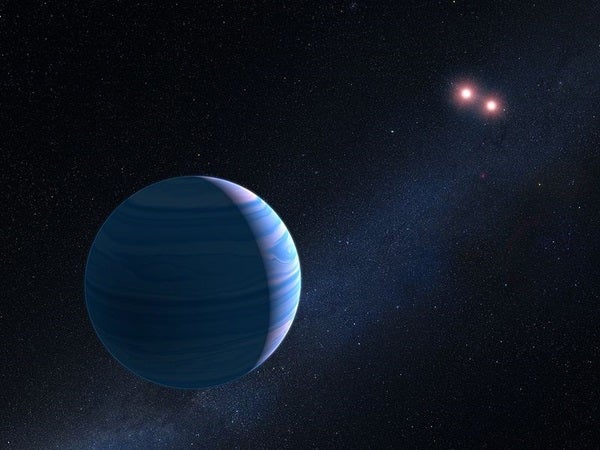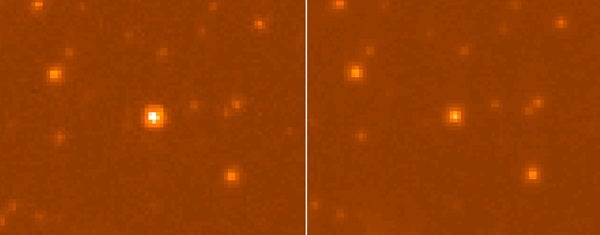Astronomers have, for the first time, found a planet orbiting a binary star system using microlensing.
Gravitational lensing is a technique that made its name by aiding in the discovery of galaxies. It observes how much a relatively nearby galaxy gravitationally warps the space around it, allowing light from a more distant galaxy to curve around the nearby galaxy and form one or more distorted images of the distant galaxy.
Microlensing applies the same principle to observing stars within our own Milky Way galaxy.
The system is located 8,000 light-years away toward the center of the Milky Way. The circumbinary planet orbits roughly 300 million miles from the binary stars, at about the position of the asteroid belt in our solar system. It completes an orbit around both stars roughly every seven years. The two red dwarf stars are a mere 7 million miles apart.
The Kepler space telescope discovered 10 other planets orbiting tight binary stars by means other than microlensing, but those planets are all much closer to their stars than this one.
Survey groups such as the Optical Gravitational Lensing Experiment (OGLE) and Microlensing Observations in Astrophysics (MOA) scan the central galactic bulge, where there are lots of stars to act as sources for potential lens stars closer to Earth. When they detect a localized increase in brightness and recognize that it is heading for a high-magnification event, meaning that the near lens star is closely aligned with the far source star, other observatories around the world train their telescopes on the spot.
“There has to be some magnification before the OGLE or MOA telescopes can identify it as a microlensing event, but since MOA and OGLE or both are surveying the sky regularly, they have data before it was magnified,” says David Bennett, an astrophysicist at NASA’s Goddard Space Flight Center in Greenbelt, Md., and lead author of the paper announcing the microlensing results. The paper has been accepted for publication in the Astronomical Journal (“The First Circumbinary Planet Found by Microlensing: OGLE-2007-BLG-349L(AB)c”).
The time for the source and lens stars to move through their alignment is much faster than for a pair of galaxies, so astronomers can view the whole event. It is still slow enough, however — 118 days for this event — for follow-up telescopes to be notified in time to focus on it before it reaches peak magnification.
OGLE in Chile and MOA in New Zealand were joined by the Microlensing Follow-up Network (MicroFUN) based at Ohio State University with telescopes around the world, the Probing Lensing Anomalies Network (PLANET) based in Paris with telescopes around the world, and the RoboNet Collaboration with telescopes in the Canary Islands, Hawaii, and Australia to measure the light curve from the microlensing event.
By analyzing the light curve from the ground-based observations, Bennett and the whole worldwide team knew the lensing “star” was actually a three-body system, but they couldn’t tell whether it was two stars and a planet or one star and two planets.
“If you look at a million stars in the central galactic bulge region, there may be two or three that are lensed at any given time,” says Bennett. “The reason we’re looking at the central galactic bulge is that’s sort of the highest probability we can get. If we looked somewhere else, the probability would be lower.”
The problem with scanning the central galactic bulge for lensing events is that the stars in the bulge are packed so close together that Earth-based telescopes are not able to distinguish individual stars. OGLE and MOA have to use difference imaging to search for localized increases in the brightness of light that is blended together from stars in the bulge.
Fine viewing
The Hubble Space Telescope (HST) contributed to the study of the lens system by using its superior angular resolution in space to pick out the background source star and the lensing star from their neighbors in the very crowded star field.
The final chunk of data the astronomers needed to nail down the structure of OGLE-2007-BLG-349 came from analyzing the “microlensing parallax” views of the system.
Telescopes at different locations on Earth saw the lensing event from very slightly different perspectives.
“They see a different alignment between the lens and the source star, so they would see a different light curve,” says Bennett. “You can see the same effect due to the orbital motion of the Earth. The measurement of these effects allowed us to determine the total mass of the lens system.”
The microlensing event reached its peak magnification in September 2007, when the orbital motion of Earth was nearly perpendicular to the line of sight to the lens, so the microlensing parallax had a bigger effect on the light curve than it would have otherwise.
Analyzing the light curves from the Hubble and ground-based observations revealed the brightness and mass of the source and lens stars. What the astronomers saw was that the starlight from the foreground lens system was too faint to be a single star with its apparent mass. One star containing that much mass would be brighter than what was observed. It was consistent with the brightness expected for two closely orbiting red dwarf stars, which are fainter and less massive than our sun.
A different perspective
Microlensing has some advantages over other methods of detecting exoplanets.
“Microlensing is the most promising technique for finding planets from about one to 10 AU [astronomical units] from their host stars,” says Jennifer C. Yee, an astrophysicist at the Harvard-Smithsonian Center for Astrophysics and a NASA Sagan fellow. “In contrast to radial velocities and direct imaging, which can find giant planets at these separations, microlensing can find planets of all masses.”
Yee was not involved in the investigation of OGLE-2007-BLG-349. “The conclusion that the host is actually a binary star rather than a single star comes from detailed modeling of the light curve as well as the HST detection of light from the lens itself,” she says. “This is a very thorough investigation of a complex microlensing system.”
“Microlensing is sensitive to planetary systems that can’t be found by other methods,” says Bennett. “The Kepler Space Telescope and the transit method and the radial velocity method are most sensitive to planets in very short-period orbits, very close to their stars.” Microlensing is most sensitive to planets at a distance from their star of two to four times Earth’s orbital radius.
Microlensing is also the most sensitive technique for finding planets beyond the “snow line,” according to Bennett.
“This is the region in the protoplanetary disc where it becomes cold enough for ices to condense,” he says, “primarily water ice but also carbon monoxide ice, CO2 ice, methane ice.”
Beyond the snow line, there is more solid material for making rocky-icy planets or to form the core of gas giant planets.
Microlensing will get a big boost with the flight of the Wide Field InfraRed Survey Telescope (WFIRST) space telescope, which is scheduled to launch in the mid-2020s, which will devote about 20% of its observing time to a microlensing survey for exoplanets. From its vantage point at the Sun-Earth Lagrange 2 point, WFIRST should have the resolution to advance the microlensing endeavor.
Allen Zeyher is a freelance writer in the Chicago area.











